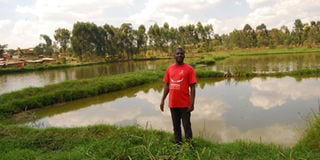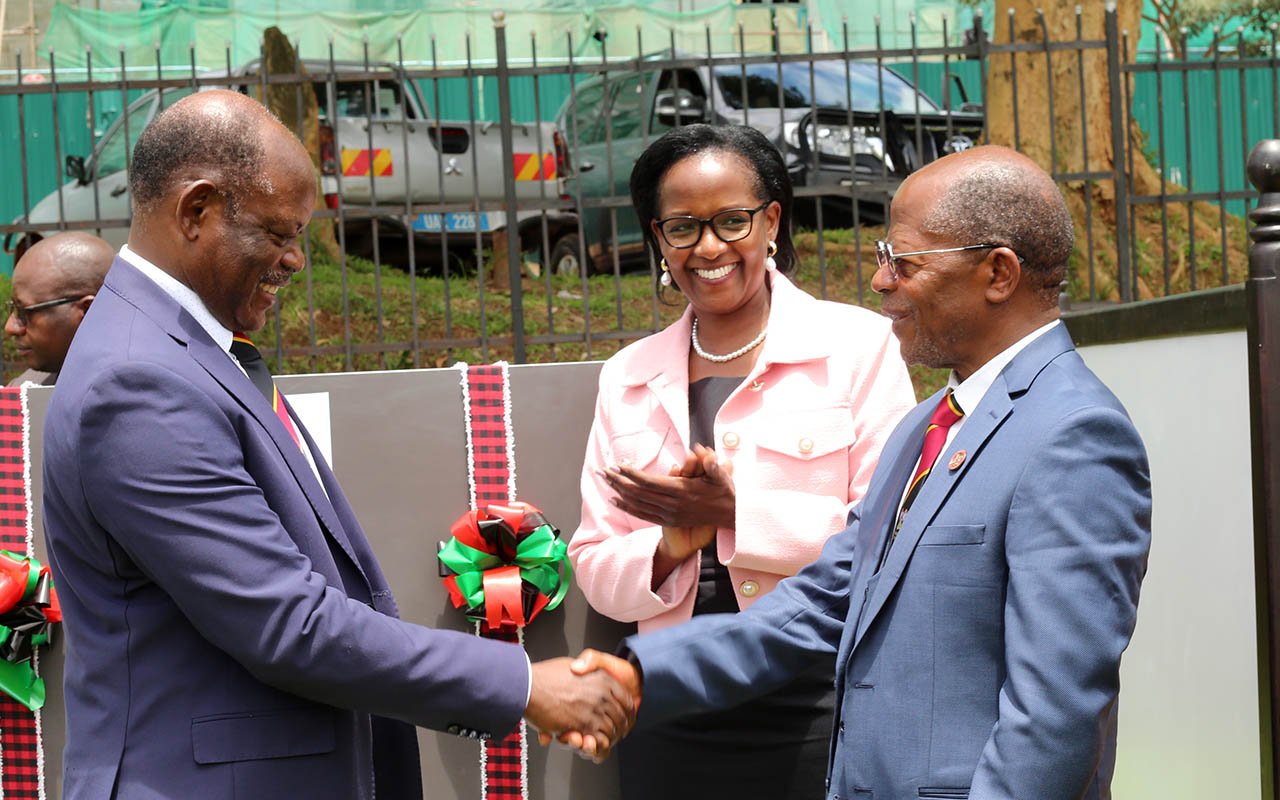Costly fish feeds sinks farmers in huge losses

Mr Mark Mutabuuza, a fish farmer, stands next to his ponds in Ruti Ward, Mbarara City, on August 1, 2020. PHOTO | ALFRED TUMUSHABE
Fish farmers in western region travel as far as Wakiso, Kajjansi, Jinja, Mbale and Tororo in eastern Uganda to buy quality fish fingerlings (fish seed) due to lack of suppliers in the sub-region.
Kajjansi hatchery in Wakiso District is government owned. The government owned hatchery in Ruhandagazi in Bushenyi Municipality that is supposed to be serving farmers in the sub-region operates at a very small scale partly due to limited funding.
“There are high quality seeds in Kajjansi and sometimes you have to book three months in advance (because of high demand),” says Mr Deus Tumusiime, a fish farmer and former chairperson of Mbarara. He suggests that government should lease the hatchery in Bushenyi District to someone who is able to provide inputs to farmers.
“Most farmers in the region don’t have information on where hatcheries are found, and not all people can afford to go to these far places. When the seed is very far, it becomes expensive and by their delicate nature, it means you have to handle them with extra care during transportation,” he said.
Mr Tumusiime has been in fish farming business for 20 years. He harvests about six tonnes every season (after eight months).
He adds that if one wants to stock 5,000 fingerlings of catfish, it will cost Shs2 million while stocking the same number of tilapia will cost Shs1.5 million. Feeding will take at least Shs2 million up to the time of harvesting, which is eight to 10 months.
“There is good money. Of 5,000 fish, you are sure of getting not less than Shs30 million, but that is if you do everything right, right seed, right feeds, right management and quality water,” says Mr Tumusiime.
It is not only fingerlings that are costly but also fish feeds. As a result, after acquiring the seed, some farmers provide food that is not recommended like maize brand. Others just leave fish in ponds without providing feeds. This means they cannot reap much from the enterprise.
“Feeds are very expensive and are not readily available in the market. Those readily are of poor quality. Quality feeds are imported. In fish farming, feeding constitutes 60 per cent of the total cost of production,” says Amos Besigye, a fish farmer in Rwampara District and the fisheries officer in Ntungamo District.
He buys feeds manufactured by Koudijs Animal Nutrition, a Netherlands Company. Mr Besigye advises government to improve support they give to fish farmers through National Agriculture and Advisory Services (Naads).
“The government intervention in fish farming is minimal; the support is not as much as what is given to the crop and livestock sectors. Naads last gave us inputs (seeds and feeds) in 2018 and they contracted a local person to provide feeds, which are not of good quality,” says Mr Besigye.
Mr Nicholas Abomugisha, the senior fisheries officer in Mbarara, concurs with Mr Besigye.
“Some companies sell poor quality feeds, they cheat on the protein content, which is the most important element in the feeds; they say it’s 30 per cent but when actually its 10 per cent, especially the indigenous companies, they are unethical. When you feed fish on that, you don’t get what you expected to get,” says Mr Abomugisha.
Government support
“Government has been giving support in terms of feeds and seed but they last did that in 2018. They have now asked us to compile a list of farmers who can be supported with fingerlings, and that comes with startup feed for three months,” he adds.
Mr Ronald Rubeihayo, the principal fisheries officer in Rubirizi District, says they introduced cage fish farming on four of the 32 crater lakes in the district. The fish food is imported which makes it expensive.
“We are doing cage farming on four lakes but getting feeds is a challenge, they are not available in the country. When you are doing cage farming, you need floating feeds, that quality is not in Uganda, it is imported from Mauritius. They are expensive with each kilogramme costing Shs 5,000,” he says.
Farmers in Rubirizi also travel far places for fingerings while others buy from a local breeder in Kyamuhunga. Mr Rubeihayo says the hatchery in Bushenyi cannot satisfy the market as there is only tilapia on small scale.
Mr Zephine Tumwesigye, the principal fisheries officer of Ibanda District, says: “Farmers are using locally mixed feeds; they are avoiding the expensive ones, yet they don’t have the nutrients necessary for fish growth. Our farmers don’t have easy access to fish seed.”
Mr Mark Mutabuuza, a fish farmer in Ruti Ward in Mbarara City, says he buys catfish and tilapia seeds from Kajjansi, which is costly because of transport. He also says fishing gears like nets are very expensive.
“People have realised that fish is an important food. When we harvest, the stock is exhausted immediately. The challenge now is the high cost of production,” says Mr Mutabuuza.
Farmers sell fish in local urban markets and DR Congo through Mpondwe border market in Kasese District. The farm gate price of fish weighing a kilogramme is between Shs8,000 and Shs12,000.
Mr Abomugisha says the cost of tilapia fingerling is between Shs150 and Shs200 while catfish fingering costs between Shs200 and Shs250.
The average cost of a kilogramme of fish feed is Shs3,800. At eight months when fish harvesting begins, fish in a pond will have fed on at least 650 gms to 750 gms of food.
A tilapia will be weighing 400gms to 600gms while catfish will be weighing 600gms to 800gms.
Government plan
The State Minister for Fisheries, Ms Hellen Adoa, says government plans to establish and operationalise regional fish hatcheries.
“We are looking at establishing a hatchery for every region. Government built for Teso but it is not working because of the quality of water. There is a hatchery in Bushenyi which we are going to operationalise fully. We are looking at all the regions. We want to decongest lakes; we are going to support fish farmers,” Ms Adoa said.
“We are going to have locally-made quality fish feeds by supporting privates companies that can make the feeds,” she added.
The number of fish famers in selected districts, provided by the respective fisheries officers, include Mbarara 92, Isingiro 60, Rwampara 70, Ntungamo 124, Ibanda 36 and Rubirizi 124. The biggest commercial fish farmer in Mbarara has 12 ponds (of 500 square metres each).
Mr Charles Mulondo, the Bushenyi fisheries officer declined to comment on the state of the government hatchery. He referred us to the district’s principal fisheries officer, Mr David Bainomugisha, who could not be reached by press time.




